Non-fatal injuries 19 | Start date July 18, 1984 Perpetrator James Huberty | |
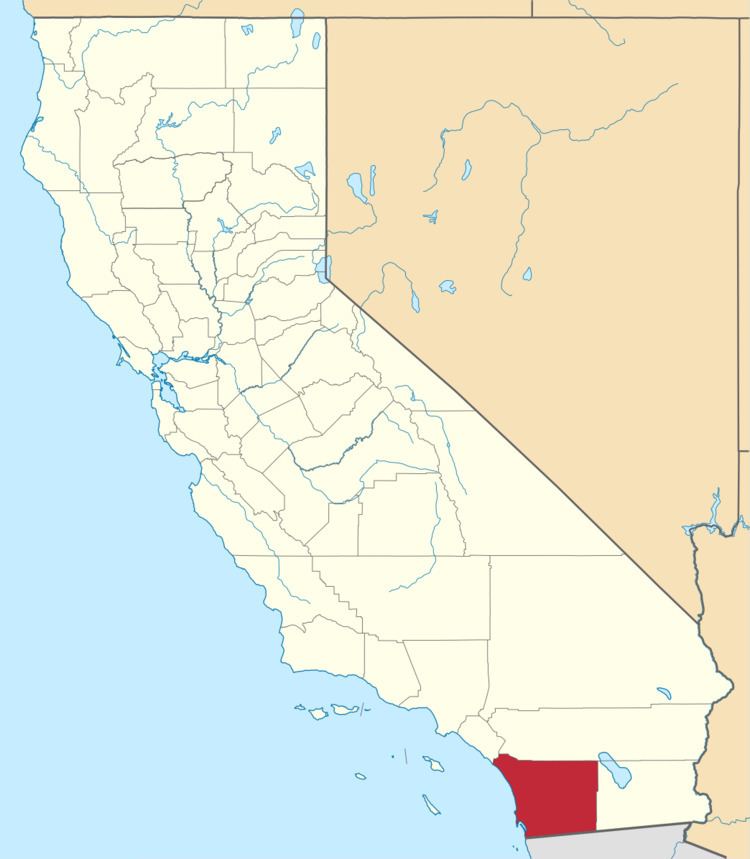 | ||
Weapons 9mm Browning HP semi-automatic pistol, Uzi 9mm semi-automatic carbine, Winchester 1200 pump-action shotgun (12 gauge) Similar Lubys shooting, Sydney River McDonald's murders, Virginia Tech shooting Coordinates 32°33′21.2″N 117°03′15.0″W Target Staff and customers at McDonald's Deaths 23 (including the perpetrator and an unborn child) Motive Inconclusive (possibly rage, suicidal ideation, and/or revenge) | ||
Jerry Sanders shares memories of 1984 San Ysidro McDonald's Massacre 14 years later in 1998
The San Ysidro McDonald's massacre was a mass shooting that occurred in and around a McDonald's restaurant in the San Diego neighborhood of San Ysidro on July 18, 1984. The perpetrator, 41-year-old James Huberty, shot and killed 21 people and injured 19 others before being fatally shot by a SWAT team sniper.
Contents
- Jerry Sanders shares memories of 1984 San Ysidro McDonalds Massacre 14 years later in 1998
- Prior to incident
- Shooting
- End of incident
- Perpetrator
- Aftermath
- References
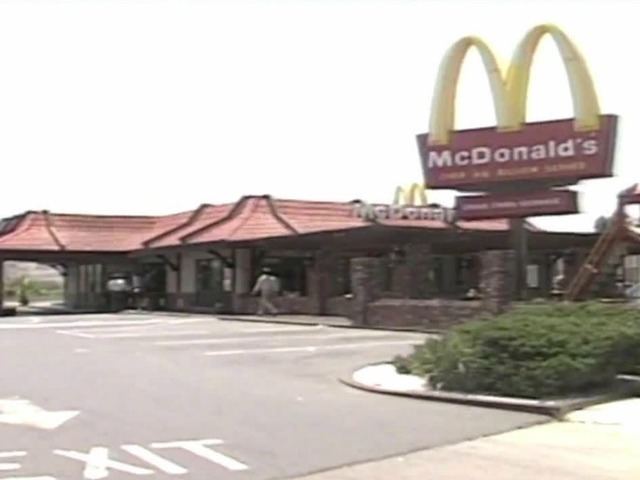
The shooting ranked as the deadliest mass shooting committed in the United States until the 1991 Luby's shooting.
Prior to incident
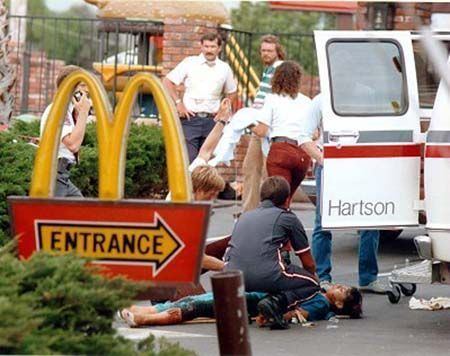
On July 15, 1984, three days before the shooting, Huberty commented to his wife, Etna, that he suspected he might have a mental problem. Two days later, on July 17, he called a mental health clinic, requesting an appointment. Leaving his contact details with the receptionist, he was assured the clinic would return his call within hours. According to his wife, he sat quietly beside the telephone for several hours, awaiting the return call, before abruptly walking out of the family home and riding to an unknown destination on his motorcycle. Unbeknownst to Huberty, the receptionist had misspelled his name as "Shouberty". His polite demeanor conveyed no sense of immediate urgency to the operator; therefore, the call was logged as a "non-crisis" inquiry, to be handled within 48 hours.

Approximately one hour later, Huberty returned home in a contented mood. After eating dinner, he, his wife, and their two daughters (aged 12 and 10) cycled to a nearby park. Later that evening, he and Etna watched a film together.
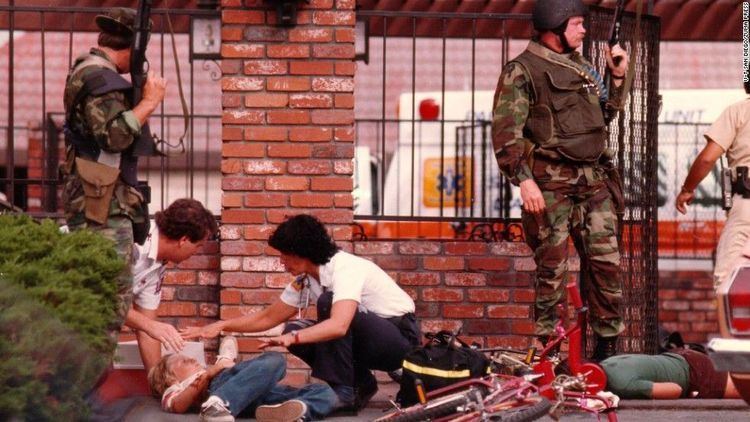
The following morning—Wednesday, July 18—Huberty took his wife and daughters to the San Diego Zoo. In the course of the walk, he told his wife his life was effectively over. Referring to the mental health clinic's failure to return his phone call the previous day, he said, "Well, society had their chance."
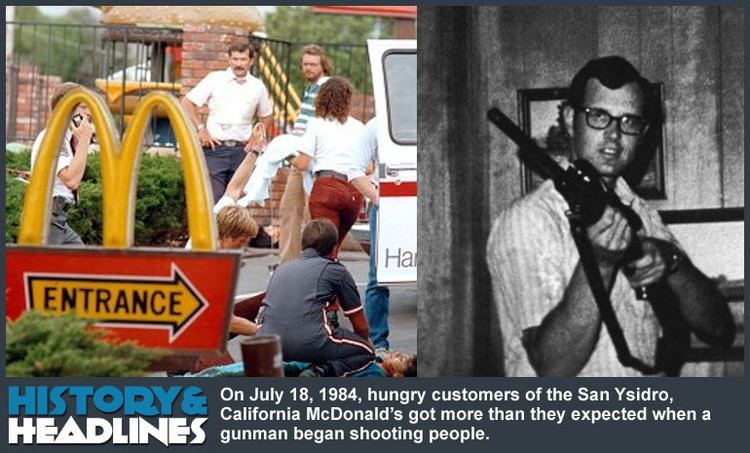
After eating lunch at a McDonald's restaurant in the Clairemont neighborhood of San Diego, the Hubertys returned home. Shortly thereafter, he walked into his bedroom as his wife lay relaxing upon the bed; he leaned toward her and said, "I want to kiss you goodbye." Etna asked him where he was going, to which he replied he was "going hunting humans".
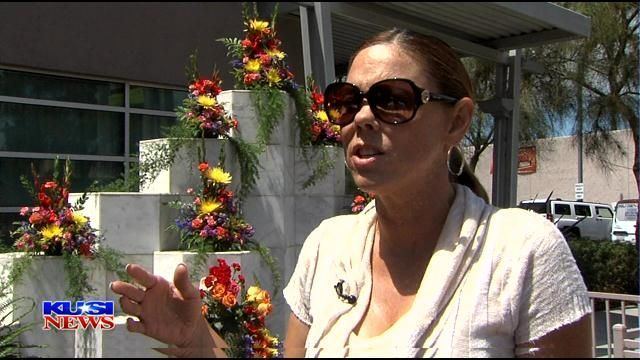
Carrying a bundle wrapped in a checkered blanket, Huberty looked toward his elder daughter, Zelia, as he walked toward the front door of the family home and said, "Goodbye. I won't be back." He drove down San Ysidro Boulevard. According to eyewitnesses, he drove first toward the Big Bear supermarket and then toward the U.S. Post Office, before entering the parking lot of a McDonald's restaurant located approximately 200 yards from his apartment.
Shooting
At approximately 3:56 p.m. on July 18, James Huberty drove his black Mercury Marquis sedan into the parking lot of the McDonald's restaurant on San Ysidro Boulevard. In his possession were a 9mm Browning HP semi-automatic pistol, a 9mm Uzi carbine, a Winchester 12 gauge pump-action shotgun, and a cloth bag filled with hundreds of rounds of ammunition for each weapon. A total of 45 customers were present inside the restaurant.
Entering the restaurant minutes later, Huberty first aimed his shotgun at a 16-year-old employee named John Arnold. The assistant manager, Guillermo Flores, shouted, "Hey, John. That guy's going to shoot you." According to Arnold, when Huberty pulled the trigger, "nothing happened". As Huberty inspected his gun, the manager of the restaurant, 22-year-old Neva Caine, walked toward the service counter of the restaurant in the direction of Arnold, as Arnold—believing the incident to be a distasteful joke—began to walk away from the gunman. Huberty fired his shotgun toward the ceiling before aiming the Uzi at Caine, shooting her once beneath her left eye. Caine died minutes later.
Immediately after shooting Caine, Huberty fired his shotgun at John Arnold, wounding the youth in the chest, before shouting a comment to the effect of, "Everybody on the ground." Huberty referred to all present in the restaurant as "dirty swines", shouting that he had killed thousands and that he intended to "kill a thousand more". Upon hearing Huberty's expletive-ridden rants and seeing Caine and Arnold shot, one customer, 25-year-old Victor Rivera, tried to persuade Huberty not to shoot anymore. In response, Huberty shot Rivera 14 times, repeatedly shouting "Shut up" as Rivera screamed in pain.
As most of the customers tried to hide beneath tables and service booths, Huberty turned his attention toward six women and children huddled together. He first shot and killed 19-year-old María Colmenero-Silva with a single gunshot to the chest, then fatally shot 9-year-old Claudia Perez in the stomach, cheek, thigh, hip, leg, chest, back, armpit, and head with his Uzi. He then wounded Perez's 15-year-old sister Imelda once in the chest with the same weapon, and fired upon 11-year-old Aurora Peña with the shotgun. Peña—initially wounded in the leg—had been shielded by her pregnant aunt, 18-year-old Jackie Reyes. Huberty shot Reyes 48 times with the Uzi. Beside his mother's body, 8-month-old Carlos Reyes sat up and wailed, whereupon Huberty shouted and killed the infant with a single pistol shot to the center of the back.
Huberty shot and killed a 62-year-old trucker named Laurence Versluis, before targeting one of the families near the play area of the restaurant, who had tried to shield their children beneath the tables with their bodies. Blythe Regan Herrera (aged 31) had shielded her 11-year-old son, Mateo, beneath one booth, and her husband protected 12-year-old Keith Thomas under a booth across from them. Huberty began shooting people seated in the restaurant as he walked toward those under the tables. Ronald Herrera urged Thomas not to move, shielding the boy with his body. Thomas was shot in the shoulder, arm, wrist, and left elbow, but was not seriously wounded; Ronald Herrera was shot eight times in the stomach, chest, arm, and head but survived; his wife, Blythe, and son, Mateo, were both killed by numerous gunshots to the head.
Nearby, two women tried to hide beneath a booth. Guadalupe del Rio, 24, was against a wall; she was shielded by her friend, 31-year-old Arisdelsi Vuelvas Vargas. Del Rio was hit several times in the back, abdomen, chest, and neck, but was not seriously wounded, whereas Vargas received a single gunshot wound to the back of the head. She died of her wound the next day, the only person fatally wounded who lived long enough to reach a hospital. At another booth, Huberty killed 45-year-old banker Hugo Velazquez Vasquez with a shot to the chest.
The first of many calls to the emergency services was made at 4:00 p.m., although the dispatcher mistakenly directed responding officers to another McDonald's two miles (three kilometers) from the San Ysidro Boulevard restaurant. Within ten minutes, the police had arrived at the correct restaurant. They imposed a lockdown on an area spanning six blocks from the site of the shootings. The police established a command post two blocks from the restaurant, and deployed 175 officers in strategic locations (These officers were joined within the hour by SWAT team members, who also took positions around the McDonald's restaurant).
Shortly after the first 9-1-1 call had been made, a young woman named Lydia Flores drove into the parking lot. Stopping at the food pickup window, Flores noticed shattered windows and the sound of gunfire, before "looking up and there he was, just shooting". Flores reversed her car until she crashed into a fence; she hid with her two-year-old daughter until the shooting ended. Three 11-year-old boys rode their bikes into the west parking lot to purchase soft drinks. Hearing a member of the public yell something unintelligible from across the street, all three hesitated, before Huberty shot the three boys with his shotgun and Uzi. Joshua Coleman fell to the ground critically wounded in the back, arm, and leg; he later recalled looking toward his two friends, Omarr Alonso Hernandez and David Flores Delgado, noting that Hernandez was on the ground with multiple gunshot wounds to his back and had started vomiting; Delgado had received several gunshot wounds to his head. Coleman survived; Hernandez and Delgado both died at the scene. Huberty next noticed an elderly couple, Miguel Victoria Ulloa (74) and Aida Velazquez Victoria (69), walking toward the entrance. As Miguel reached to open the door for his wife, Huberty fired his shotgun, killing Aida with a gunshot to the face and wounding Miguel. An uninjured survivor, Oscar Mondragon, later reported that he had seen Miguel cradling his wife in his arms and wiping blood from her face. Miguel shouted curses at Huberty, who approached and killed him with a shot to the head.
At approximately 4:10 p.m., a Mexican couple, Astolfo and Maricela Felix, drove toward one of the service areas of the restaurant. Noting the shattered glass, Astolfo initially thought renovation work was in progress and that Huberty—striding toward the car—was a repairman. Huberty fired his shotgun and Uzi at the couple and their 4-month-old daughter, Karlita, striking Maricela in the face, arms and chest, blinding her in one eye and permanently rendering one hand unusable. Her baby was critically wounded in the neck, chest and abdomen. Astolfo was wounded in the chest and head. As Astolfo and Maricela staggered away from Huberty's line of fire, Maricela put her shrieking child into the arms of a fleeing woman and shouted in Spanish, "Please save my baby", before slumping against a parked car. The woman rushed the baby to a nearby hospital as her husband assisted Astolfo and Maricela into a nearby building. All three members of the Felix family survived.
Several survivors later said they saw Huberty walk toward the service counter and adjust a portable radio, possibly to search for news reports, before selecting a music station and returning to shooting. Shortly thereafter, he searched the kitchen area, discovering six employees. He opened fire, killing 21-year-old Paulina López, 19-year-old Elsa Borboa-Fierro, and 18-year-old Margarita Padilla, and critically wounding 17-year-old Alberto Leos. Padilla had urged her colleague, 17-year-old Wendy Flanagan, to run, before being fatally shot. Flanagan, four other employees and a female customer hid inside a basement utility room. They were joined by Leos, who had crawled to the utility room after being shot multiple times.
When a fire engine drove within range, Huberty repeatedly pierced the vehicle with bullets, but did not wound any occupants. Hearing a wounded teenager, 19-year-old Jose Pérez, moaning, Huberty fatally shot him in the head; the boy slumped dead in the booth. Pérez died alongside his friend and neighbor, 22-year-old Gloria González, and a young woman named Michelle Carncross. At one point, Aurora Peña, who had lain wounded beside her dead aunt, baby cousin and two friends, noted a lull in the firing. Opening her eyes, she saw Huberty nearby and staring at her. He swore and threw a bag of french fries at her, then retrieved his shotgun and shot her in the arm, neck, and chest. She survived, although she would be hospitalized longer than any other survivor. Occasionally, Huberty blurted justifications before murdering his victims as he shot them.
Police had established a command post two blocks from the restaurant. They initially did not know how many shooters were inside, since Huberty was using firearms of several different types, and rapidly firing numerous shots. Because most of the restaurant's windows had been shattered by gunfire, reflections from shards of glass made it difficult for police to see inside. A police sniper who was part of the SWAT team was positioned on the roof of the post office next door to the McDonald's. He was authorized to kill Huberty should he have a clear shot.
End of incident
At 5:17 p.m., the SWAT sniper perched on the post office roof obtained an unobstructed view of Huberty from the neck down for a few seconds; he fired a single round, which entered Huberty's chest, severed the aorta just under his heart, and exited through his spine, leaving an exit wound one inch square and sending him sprawling backwards onto the floor directly in front of the service counter, killing him within seconds.
The incident had lasted for 78 minutes, during which time Huberty fired a minimum of 245 rounds of ammunition, killing 20 people and wounding 20 others, one of whom died the following day. Seventeen of the victims were killed inside the restaurant and four in the immediate vicinity. Several victims had tried to stanch their bleeding with napkins—often in vain.
Of the fatalities, 13 died from gunshot wounds to the head, seven from gunshots to the chest, and one victim, 8-month-old Carlos Reyes, from a single 9mm gunshot to the back.
The victims, whose ages ranged from 8 months to 74 years, were predominantly, though not exclusively, of Mexican or Mexican-American ancestry, reflecting local demographics.
Although Huberty had shouted at the beginning of his shooting spree that he had "killed thousands" in a comment indicating he was a veteran of the Vietnam War, he had never actually served in any military branch.
Perpetrator
James Oliver Huberty (October 11, 1942 – July 18, 1984) was born in Canton, Ohio to Earl V. and Icle Huberty. When he was three, he contracted polio, and even though he made a progressive recovery, the disease caused him to suffer permanent walking difficulties. In the early 1950s, his father bought a farm in the Pennsylvania Amish Country. His mother refused to live in the Amish Country, and soon abandoned her family to do sidewalk preaching for a Southern Baptist organization.
In 1962, Huberty enrolled at Malone College, where he initially studied sociology, before opting to study at the Pittsburgh Institute of Mortuary Science in Pittsburgh, Pennsylvania. In 1965, he married Etna Markland, whom he had met while attending Malone College. Shortly after his marriage, Huberty obtained his license for embalming, and obtained employment at a funeral home in Canton. He worked in this profession for two years, before opting to become a welder. Shortly thereafter, he and his wife moved to Massillon, Ohio, where daughters Zelia and Cassandra were born in 1972 and 1974 respectively.
Huberty had a history of domestic violence, with Etna filing a report with the Canton Department of Children and Family Services that her husband had "messed up" her jaw. She would produce tarot cards and pretend to read his future to pacify him and his bouts of violence, thus producing a temporary calming effect.
Huberty, a self-proclaimed survivalist, saw signs of what he thought was growing trouble in America, and believed that government regulations were the cause of business failures, including his own. He believed that international bankers were purposefully manipulating the Federal Reserve System and bankrupting the nation. Convinced that Soviet aggression was everywhere, he believed that the breakdown of society was near, perhaps through economic collapse or nuclear war. He committed himself to prepare to survive this coming collapse and, while in Canton, provisioned his house with thousands of dollars of non-perishable food and six guns that he intended to use to defend his home during what he believed was the coming chaos. According to one family acquaintance named Jim Aslanes, Huberty's home was bedecked with loaded firearms to such a degree that wherever Huberty was sitting or standing, he "could just reach over and get a gun." Furthermore, Huberty had regularly vocalized his belief that "the country wasn't treating him right; that everything was being done against the working people."
When Huberty and his family moved from Ohio to Tijuana, Mexico in October 1983, he left all but the most essential of his family's possessions in storage, but ensured he brought his gun arsenal with him. According to published reports, Huberty's wife and daughters embraced their new environs and became friendly with their neighbors, although Huberty—who spoke little Spanish—was sullen and taciturn. Within three months, the Hubertys had relocated to the San Diego suburb of San Ysidro, where they rented a two-bedroom apartment in the Cottonwood Apartments. In San Ysidro, Huberty was able to find work as a security guard, and the family relocated to an apartment on Averil Road, just one block from the McDonald's restaurant Huberty would select as the site of his murder spree on July 18. He was dismissed from this position on July 10, one week before the shooting.
Aftermath
Because of the number of victims, local funeral homes had to use the San Ysidro Civic Center to hold all the wakes. The local parish, Mount Carmel Church, held back-to-back funeral masses to accommodate all the dead.
Within two days of the mass shooting, the San Ysidro Boulevard restaurant had been refurbished and renovated. It was planning to again open for business in the hope that—as one employee commented—the restaurant would become "just another McDonald's". After discussion with community leaders, it was decided the restaurant would not reopen. The newly renovated restaurant was razed on July 28. McDonald's later built another restaurant nearby. McDonald's also announced a commitment to donate $1 million to a survivors' fund, with the widow of McDonald's founder Ray Kroc also adding a personal contribution of $100,000 to this fund.
Following the closure of the restaurant, McDonald's donated the ground to the city, with the stipulation that no restaurant be constructed upon the site. For over four years, alternate plans to convert the site into either a memorial park or a shrine to the dead were under consideration. Several makeshift memorials were built and torn down. The land was sold in February 1988 to Southwestern College for $136,000, with the agreement that a 300-square-foot area in front of the campus extension the college intended to construct be set aside as a permanent memorial to the 21 victims who died in the massacre.
The memorial consists of 21 hexagonal white marble pillars ranging in height from one to six feet, each bearing the name of one of the victims. It was designed by Roberto Valdes, a former student at Southwestern College, who said of the sculpture: "The 21 hexagons represent each person that died, and they are different heights, representing the variety of ages and races of the people involved in the massacre. They are bonded together in the hopes that the community, in a tragedy like this, will stick together, like they did." Every anniversary, the monument is decorated with flowers. On the Mexican holiday Day of the Dead, November 1, candles and offerings are brought on behalf of the victims. The monument is at 460 West San Ysidro Boulevard.
As a result of the massacre, the city of San Diego increased training for special units, and purchased more powerful firearms to better equip police to deal with such scenarios. According to one officer, who confessed to feeling "inadequate" because he had been equipped with a .38 caliber revolver: "The time had come where you had to have a full-time, committed and dedicated, highly trained, well-equipped team ... able to respond rapidly, anywhere in the city."
Family members of the victims and survivors of the massacre initiated legal actions against the McDonald's Corporation and the local franchise operator in the Superior Court of California, San Diego County. These lawsuits were eventually merged by the court and subsequently dismissed pre-trial, following a defense request for summary judgment. The plaintiffs then proceeded to file an appeal against this decision. On July 25, 1987, the California Court of Appeal affirmed summary judgment for the defendants because (1) McDonald's or any other business has no duty of care to protect patrons from an unforeseeable assault by a murderous madman; and (2) plaintiffs could not prove causation because the standard reasonable measures normally used by restaurants to deter criminals, such as guards and closed-circuit television cameras, could not possibly have deterred the perpetrator, because he did not care about his own survival.
In the weeks following the massacre, Huberty's wife and daughters stayed with a family friend. Amidst impromptu protests from some residents, Etna received the first payout from the survivors' fund. In 1986, she unsuccessfully sued both McDonald's and Babcock & Wilcox, her husband's longtime former employer, in an Ohio state court for $5 million. The suit claimed that the massacre was triggered by both a poor diet, and her husband working around highly poisonous metals, further citing that monosodium glutamate in McDonald's food, combined with the high levels of lead and cadmium discovered in Huberty's body at his autopsy — most likely built up from fumes inhaled during his 14 years of welding at Babcock & Wilcox — had induced delusions and uncontrollable rage. (Autopsy results revealed there were no drugs or alcohol in his system at the time of the killings.)
James Huberty's body was cremated on July 23, 1984. His ashes were interred in his home state of Ohio. Etna Huberty and her daughters relocated from San Ysidro to the nearby town of Spring Valley, where her daughters enrolled in school under assumed names. Etna Huberty died of breast cancer in 2003.
Survivor Alberto Leos became a police officer; he served in several police departments in the South Bay, eventually joining the San Diego Police Department.
